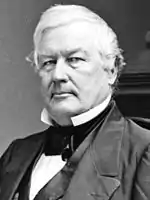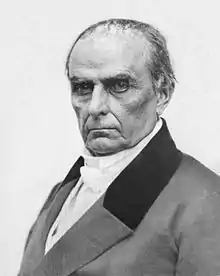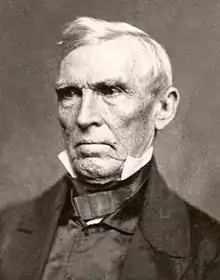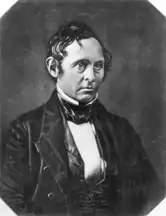1852 Whig National Convention
The 1852 Whig National Convention was a presidential nominating convention held from June 17 to June 20, in Baltimore, Maryland. It nominated the Whig Party's candidates for president and vice president in the 1852 election. The convention selected General-in-Chief Winfield Scott (commanding the United States Army and led in the recent war with Mexico) for president and U.S. Secretary of the Navy William A. Graham for vice president.
| 1852 presidential election | |
 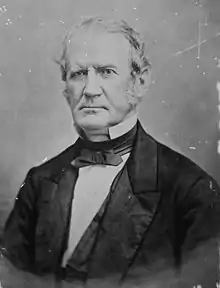 Nominees Scott and Graham | |
| Convention | |
|---|---|
| Date(s) | June 17–20, 1852 |
| City | Baltimore, Maryland |
| Venue | Maryland Institute for the Promotion of the Mechanic Arts (now Maryland Institute College of Art) |
| Chair | John G. Chapman |
| Candidates | |
| Presidential nominee | Winfield Scott of New Jersey |
| Vice presidential nominee | William A. Graham of North Carolina |
| Voting | |
| Total delegates | 296 |
| Votes needed for nomination | 149 |
| Results (president) | Scott (NJ): 159 (53.72%) Fillmore (NY): 112 (37.84%) Webster (MA): 21 (7.09%) Blank: 4 (1.35%) |
| Results (vice president) | Graham (NC): 296 (100%) |
| Ballots | 53 |
In the aftermath of the Mexican–American War (1846–1848) and the Compromise of 1850, the Whig Party was torn over the issue of slavery. President Millard Fillmore, who had succeeded to the presidency in July 1850 after the death of President Zachary Taylor, had the strong backing of Southern Whigs. However, his enforcement of the Fugitive Slave Act of 1850 had alienated many Northern Whigs, who supported either Scott or Secretary of State Daniel Webster. Scott and Fillmore essentially tied on the first presidential ballot, while a smaller fraction of the vote went to Webster. There was little delegate movement over the next 46 ballots, but Scott gained momentum on the 48th ballot and clinched the nomination on the 53rd ballot.
Graham, Edward Bates of Missouri, and James Pearce of Maryland all won significant support on the first vice presidential ballot, but Graham clinched the nomination on the second ballot. In the general election, Scott and Graham were defeated by the Democratic candidates, Franklin Pierce and William R. King who took office the following March 1853. This 1852 convention was the last Whig Party presidential convention to be held independent of other parties, as the 1856 Whig National Convention was held by a rump faction of Whigs and nominated the ticket previously selected by the competing 1856 American National Convention.
Schedule
The Congressional Whig caucus, led by North Carolina Senator Willie P. Mangum, a supporter of Scott, met on April 9, 1852, to decide the date and location for the 1852 convention. The party chose to hold the convention in Baltimore, Maryland, at the Maryland Institute for the Promotion of the Mechanic Arts (now the Maryland Institute College of Art), an assembly hall/auditorium with classrooms on second floor built above arched brick piers for Centre Market (also known as "Marsh Market" from the colonial era Harrison's Marsh area) below on ground level), built 1851, on East Baltimore Street at Market Place/South Frederick Street on the west bank of the Jones Falls (stream – flows into the Patapsco River and Baltimore harbor) during the second week of June. Also later site of "Sanitary Fair" held to support Union Army and Navy soldiers and sailors' domestic and health needs sponsored by U.S. Sanitary Commission during the Civil War and site of famous Abraham Lincoln visit and "Liberty Speech" (or "Baltimore Address") on April 18, 1864. The site often used for numerous assemblies, mass meetings and conventions during the later half of the 19th century, burned during the Great Baltimore Fire of February 1904.[1]
Pre-convention
In late 1851 and early 1852, state conventions began to meet to select delegates to the national convention. The party was split between those who felt that Fillmore could not win the election and those who favored the president's nomination. Northern Whigs favored Scott while Southern Whigs tended to prefer Fillmore.
The party was also torn on the issue of slavery. Most in the party wanted to prevent slavery from becoming the dominating issue in the election. However, the Whigs were split on the issue of the Compromise of 1850, proposed and designed by Whig Senator Henry Clay of Kentucky. President Zachary Taylor, a Southern Whig, had tried to avoid the issue altogether by proposing that California and New Mexico be admitted as free states immediately. After Taylor's death in July 1850, Fillmore, a moderate Whig, had supported Clay's compromise and was instrumental as president in its passage. Northern Whigs, led by William Henry Seward of New York, (former Governor and Senator), adamantly opposed the compromise because it did not apply the Wilmot Proviso (which banned slavery in any federal territory acquired from Mexico after the Mexican-American War) to the western territories.
Northern Whigs launched an effort to associate Scott with the Free Soil wing of the party. Scott did not agree with the Free Soilers, who opposed the expansion of slavery into the western territories. Just days before the convention was scheduled to begin, Southern Whigs warned that they would not support Scott unless he pledged to disavow the Free Soilers and to exclude them from his administration if he was elected.
Encouraged by Fillmore's professed lack of desire to pursue the Whig nomination, Webster launched another campaign for the presidency in 1851.[2] Fillmore was sympathetic to the ambitions of his secretary of state, but he was unwilling to completely rule out accepting the party's 1852 nomination, as he feared doing so would allow Seward to gain control of the party through Scott.[3] Scott had supported the Compromise of 1850, but his association with Seward made him unacceptable to Southern Whigs.[3] As Southerners retained a lingering distrust of Webster, they threw their backing behind Fillmore.[4] Thus, Scott emerged as the preferred candidate of most Northern Whigs, Fillmore became the main candidate of Southern Whigs, and Webster was only able to win backing from a handful of delegates, most of whom were from New England.[5]
On the eve of the convention, The New York Times estimated that Fillmore would have the support of 133 delegates, Scott 120 and Webster 40.
Two weeks before the Whig convention was set to begin, the Democrats nominated Franklin Pierce, a northerner from New Hampshire. Supporters of Daniel Webster in the North decided that Scott, not Fillmore, could defeat Pierce in the general election, and several switched their support.
The convention
The convention met from June 17 to June 20.
Day 1
Delegates to the fourth Whig Party National Convention assembled also in the same Maryland Institute auditorium, above "Centre Market" at Market Place/South Frederick and East Baltimore Streets, alongside the Jones Falls stream in eastern downtown Baltimore, Maryland. Although each state was granted one delegate for each of their electoral votes, several sent more than their allotted number.
The convention convened on June 17, 15 minutes before the scheduled time. Delegates quickly selected former Senator George Evans of Maine as temporary chairman. Because a large number of delegates had not yet arrived, many on the floor objected to the selection. The delegates also appointed the Whig Party's National Committee, as well as a Committee on Credentials and a Committee on Permanent Organization, before adjourning.[1]
An evening session was held later in the day. The Credentials Committee submitted a report which was adopted and the Committee on Permanent Organization was assembled.
Day 2
The second day began with the organization of the convention. Several states had sent delegations that far outnumbered their allowed size. Virginia was allotted 15 votes and sent 45 delegates. Delegates voted to restrict states to one delegate for each of its electoral votes. The convention also adopted the party's platform. Southern delegates submitted a platform, but it was rejected in favor of a relatively weak one which caused little controversy and was easily passed by a vote of 227 to 66.[1]
Presidential nomination
Presidential candidates
The divided convention began the process of nominating a candidate. Fillmore led on the first ballot, receiving 133 votes. Scott placed a close second with 131 votes. Webster received 29 votes. Five more ballots were held with little change in the vote before the convention adjourned for the weekend.
Although both Webster and Fillmore were willing to withdraw in favor of the other, their respective delegates at the convention were unable to unite around either candidate during the weekend adjournment.[6]
The delegates resumed voting on Monday. On the 8th ballot, Scott took the lead with 133 votes to 131 for Fillmore, but neither received the necessary majority for nomination. The convention was deadlocked, and a number of delegates unsuccessfully moved to allow a nomination with a plurality, rather than a majority, of votes. After the 46th ballot, with Scott ahead by seven votes (but still without a majority), the delegates voted to adjourn for the night. On the first ballot of the final day of the convention, the 47th overall, Scott still had not received the majority of votes necessary for nomination. Several more votes were taken. Fillmore lost votes on each successive ballot. On the 52nd ballot, Scott received exactly half of the vote. Scott was finally nominated on the next ballot, obtaining a majority when several delegates from New England and Virginia switched their support.
| Presidential Ballot | |||||||||||||||||||||||||||
| Ballot | 1st | 2nd | 3rd | 4th | 5th | 6th | 7th | 8th | 9th | 10th | 11th | 12th | 13th | 14th | 15th | 16th | 17th | 18th | 19th | 20th | 21st | 22nd | 23rd | 24th | 25th | 26th | 27th |
|---|---|---|---|---|---|---|---|---|---|---|---|---|---|---|---|---|---|---|---|---|---|---|---|---|---|---|---|
| Winfield Scott | 131 | 133 | 133 | 134 | 130 | 131 | 131 | 133 | 133 | 135 | 134 | 134 | 134 | 133 | 133 | 135 | 132 | 132 | 132 | 132 | 133 | 132 | 132 | 133 | 133 | 134 | 135 |
| Millard Fillmore | 133 | 131 | 131 | 130 | 133 | 133 | 133 | 131 | 131 | 130 | 131 | 130 | 130 | 130 | 130 | 129 | 131 | 131 | 131 | 131 | 131 | 130 | 130 | 129 | 128 | 128 | 128 |
| Daniel Webster | 29 | 29 | 29 | 29 | 30 | 29 | 28 | 28 | 29 | 28 | 28 | 28 | 28 | 29 | 29 | 28 | 29 | 28 | 29 | 29 | 28 | 30 | 30 | 30 | 31 | 30 | 29 |
| John J. Crittenden | 0 | 0 | 0 | 0 | 0 | 0 | 0 | 0 | 0 | 0 | 0 | 0 | 0 | 0 | 0 | 0 | 0 | 1 | 0 | 0 | 0 | 0 | 0 | 0 | 0 | 0 | 0 |
| Edward Bates | 0 | 0 | 0 | 0 | 0 | 0 | 1 | 1 | 0 | 0 | 0 | 0 | 0 | 0 | 0 | 0 | 0 | 0 | 0 | 0 | 0 | 0 | 0 | 0 | 0 | 0 | 0 |
| Daniel S. Douglas | 0 | 0 | 0 | 0 | 0 | 0 | 0 | 0 | 0 | 0 | 0 | 0 | 0 | 0 | 0 | 0 | 0 | 0 | 0 | 0 | 0 | 0 | 0 | 0 | 0 | 0 | 0 |
| Rufus Choate | 0 | 0 | 0 | 0 | 0 | 0 | 0 | 0 | 0 | 0 | 0 | 0 | 0 | 0 | 0 | 0 | 0 | 0 | 0 | 0 | 0 | 0 | 0 | 0 | 0 | 0 | 0 |
| Blank | 3 | 3 | 3 | 3 | 3 | 3 | 3 | 3 | 3 | 3 | 3 | 4 | 4 | 4 | 4 | 4 | 4 | 4 | 4 | 4 | 4 | 4 | 4 | 4 | 4 | 4 | 4 |
| Presidential Ballot | ||||||||||||||||||||||||||
| Ballot | 28th | 29th | 30th | 31st | 32nd | 33rd | 34th | 35th | 36th | 37th | 38th | 39th | 40th | 41st | 42nd | 43rd | 44th | 45th | 46th | 47th | 48th | 49th | 50th | 51st | 52nd | 53rd |
|---|---|---|---|---|---|---|---|---|---|---|---|---|---|---|---|---|---|---|---|---|---|---|---|---|---|---|
| Winfield Scott | 134 | 134 | 134 | 134 | 134 | 134 | 134 | 134 | 133 | 136 | 136 | 134 | 134 | 132 | 134 | 134 | 133 | 133 | 134 | 135 | 139 | 139 | 142 | 142 | 148 | 159 |
| Millard Fillmore | 128 | 128 | 128 | 128 | 128 | 128 | 126 | 128 | 128 | 127 | 127 | 128 | 128 | 128 | 128 | 128 | 129 | 127 | 127 | 127 | 125 | 122 | 123 | 121 | 118 | 112 |
| Daniel Webster | 30 | 30 | 29 | 30 | 30 | 29 | 28 | 28 | 29 | 28 | 29 | 30 | 29 | 32 | 30 | 30 | 30 | 32 | 31 | 30 | 27 | 30 | 27 | 28 | 25 | 21 |
| John J. Crittenden | 0 | 0 | 0 | 0 | 0 | 1 | 4 | 1 | 1 | 0 | 0 | 0 | 0 | 0 | 0 | 0 | 0 | 0 | 0 | 0 | 0 | 0 | 0 | 0 | 0 | 1 |
| Edward Bates | 0 | 0 | 0 | 0 | 0 | 0 | 0 | 1 | 1 | 0 | 0 | 0 | 0 | 0 | 0 | 0 | 0 | 0 | 0 | 0 | 0 | 0 | 0 | 0 | 0 | 0 |
| Daniel S. Douglas | 0 | 0 | 0 | 0 | 0 | 0 | 0 | 0 | 0 | 1 | 0 | 0 | 0 | 0 | 0 | 0 | 0 | 0 | 0 | 0 | 0 | 0 | 0 | 0 | 0 | 0 |
| Rufus Choate | 0 | 0 | 0 | 0 | 0 | 0 | 0 | 0 | 0 | 0 | 0 | 0 | 1 | 0 | 0 | 0 | 0 | 0 | 0 | 0 | 0 | 0 | 0 | 0 | 0 | 0 |
| Blank | 4 | 4 | 5 | 4 | 4 | 4 | 4 | 4 | 4 | 4 | 4 | 4 | 4 | 4 | 4 | 4 | 4 | 4 | 4 | 4 | 5 | 5 | 4 | 5 | 5 | 3 |

1st Presidential Ballot (Fillmore's Peak) 
53rd Presidential Ballot (Scott Nominated)
Vice Presidential nomination
Vice Presidential candidates

_-_Brady-Handy.jpg.webp)
Former Representative
Edward Bates
of Missouri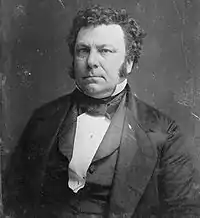
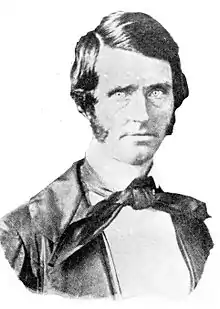
Former Representative
John W. Crockett
of Tennessee
_(14759635761).jpg.webp)
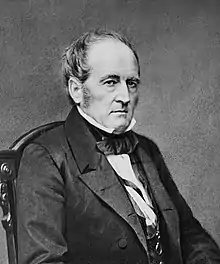

Governor
Thomas Brown
of Florida
Declined
Secretary of the Navy William A. Graham was nominated unanimously by the convention after the second ballot.
| Ballots | 1 | 2 |
|---|---|---|
| William Alexander Graham | 69 | 223 |
| Edward Bates | 97 | 62 |
| James Pearce | 42 | 4 |
| John W. Crockett | 19 | 0 |
| Edward Stanly | 14 | 0 |
| John J. Crittenden | 10 | 0 |
| Willie P. Mangum | 10 | 4 |
| James L. Petigru | 8 | 1 |
| John Bell | 5 | 0 |
| James C. Jones | 5 | 0 |
| Thomas Brown | 3 | 0 |
| Albert G. Williams | 3 | 0 |
| Henry W. Hilliard | 2 | 0 |
| Thomas Pratt | 2 | 0 |
| Alexander Stuart | 2 | 0 |
| D. B. Richardson | 1 | 0 |
| George E. Badger | 1 | 0 |
| General Latimer | 1 | 0 |
| Not Voting | 2 | 2 |

1st Vice Presidential Ballot 
2nd Vice Presidential Ballot
See also
- U.S. presidential nomination convention
- 1852 United States presidential election
- 1852 Democratic National Convention
References
- "US President – W Convention". Retrieved 2009-11-06.
- Remini 1997, pp. 724–725.
- Smith 1988, pp. 239–244.
- Holt 1999, pp. 681–682.
- Remini 1997, pp. 735–736.
- Remini 1997, pp. 736–739.
Further reading
- Holt, Michael (1999). The Rise and Fall of the American Whig Party: Jacksonian Politics and the Onset of the Civil War. Oxford University Press. ISBN 978-0-19-977203-2.
- Remini, Robert V. (1997). Daniel Webster: The Man and His Time. W.W. Norton & Company. ISBN 0-393-04552-8.
- Smith, Elbert B. (1988). The Presidencies of Zachary Taylor & Millard Fillmore. University Press of Kansas. ISBN 978-0-7006-0362-6.
Primary sources
- Chester, Edward W A guide to political platforms (1977) online
- Porter, Kirk H. and Donald Bruce Johnson, eds. National party platforms, 1840-1964 (1965) online 1840-1956
.jpg.webp)
